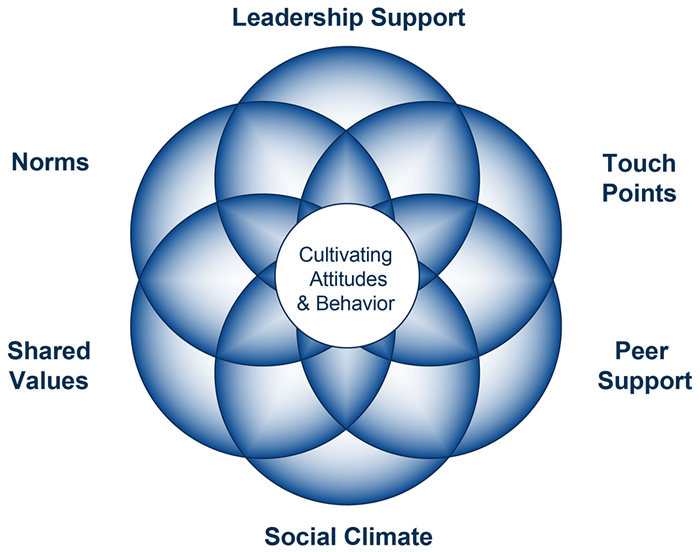Cultures and sub-cultures are complex webs of social influences
A six dimensional model of culture fleshes out some of the many ways social environments at work, at home and in the community can support well-being.
Peer Support. Emotional and instrumental support from friends, family and coworkers can help make change easier to achieve. It is often helpful to mobilize this natural support system. Buddy system, mentoring programs and team activities are important peer support programs. Peer support initiatives enhance peoples’ comfort level and capacity to provide effective support.
Touch Points. Informal and formal policies and practices shape norms and influence attitudes and behavior. Strengths and opportunities exist for aligning the following cultural touch points:
- Resource Commitment
- Built Environment
- Communication and Information
- Rewards and Recognition
- Goal Setting and Planning
- Relationship Development (Make it Social)
- Learning and Training
- Modeling
- Push-back
- Onboarding
- Traditions and Symbols
- Story and Narrative
- Roles and Responsibilities
- Laws and Policies
Shared Values. Culture goals need to make the list of important organizational priorities. The benefits of the new culture are identified and the case is tailored to the in interest of cultures and sub-cultures.
Norms. These cultural expectations for how to think and behave often operate at a sub-conscious level. It is “Just the way we do things around here.” The goal is to weaken norms that are inconsistent with the desired culture. Another culture goal is to strengthen norms that are consistent with the desired culture or to create new positive norms.
Social Climate. The morale and social cohesiveness of groups are both health determinants and important to collaborative changes. When people don’t get along, change grinds to a halt. Three social climate factors ─ a sense of community, a shared vision and a positive outlook ─ can be strengthened to support individual well-being and culture change.
Leadership Support. Leaders at all levels can develop their capacity to:
- Share the organization’s culture vision
- Serve as a role model
- Align formal and informal programs, policies and practices with the desired culture
- Track and celebrate success
- Strengthen the social climate
- Adopt a step-by-step (i.e. systematic) plan for fostering the new culture


